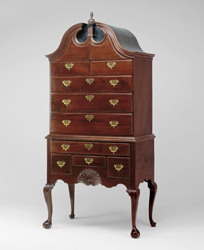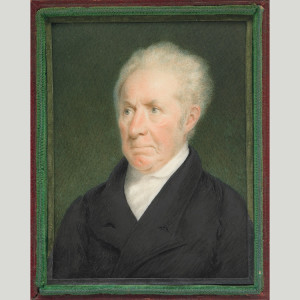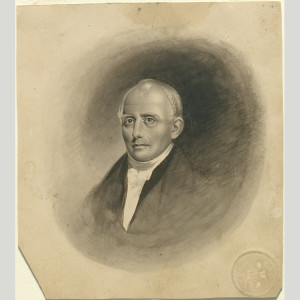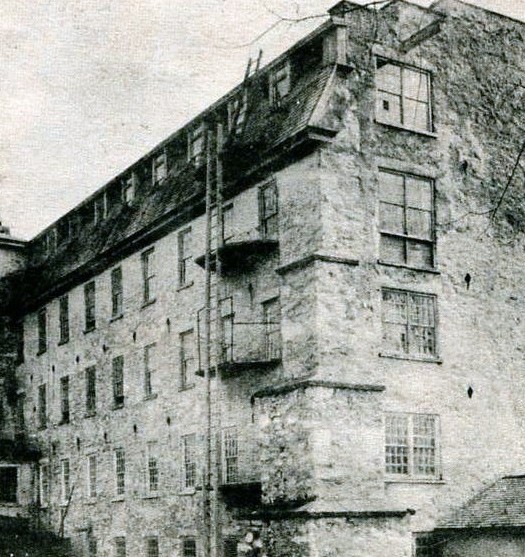Here is my list of the top ten Rhode Islanders from the eighteenth century. My list is not in any particular order. And I found it necessary to include eleven!
(1) Captain DANIEL FONES of Wickford, 1713-1790
Led by Massachusetts Governor William Shirley, many of the British colonies resolved in 1744 to capture the French fortress-city of Louisbourg on the far northeast corner of Cape Breton, Nova Scotia, Canada, in an effort to prevent what seemed to be at the time an almost certain French conquest of British America. When the fleet of New England troop transports was nearing its destination, the powerful French frigate La Renommee appeared out of the fog, capable of destroying the entire operation. Captain Daniel Fones, who commanded the Rhode Island Navy’s tiny 14-gun brig Tartar, brilliantly and courageously attacked the frigate. While his crew and ship suffered relatively little in retaliatory damage, Fones drew the enemy ship far away from the New England fleet, thus allowing the New England force to capture Louisbourg in June 1745. Therefore, it could be argued that the United States speaks primarily English today and not primarily French thanks to Fones. A tavern built by him in Wickford still stands.
(2) Governor STEPHEN HOPKINS of Providence, 1707-1785
Hopkins, a Quaker, was a self-taught lawyer, shipping-merchant, and politician-statesman who served several terms as governor and chief justice of Rhode Island. He started his political career at age twenty-three as Justice of the Peace for Scituate. He was an early advocate for the worth of paper money to shape the economy of the future. He was particularly conscious of tiny Rhode Island’s role in the future of America. As a result, he captained the privateer Reprisal in the war against France in 1745. He founded the Providence Library & Athenaeum in 1753. He was a strong supporter of Benjamin Franklin’s Albany Plan of Union in 1754, although it turned out that neither Rhode Island or any of the other colonies were ready yet for a union. He established the newspaper Providence Gazette & Country Journal. He persuaded famed architect Peter Harrison to design the Colony House for Providence in 1762. He was a driving force behind the founding of Brown University (then called the College at Rhode Island) and its location in Providence. He ordered gunners at Fort George on Goat Island off Newport to fire the first shots of resistance against British authority in America in the Saint John incident in Newport. He wrote the influential pamphlet protesting Great Britain’s encroaching on taxation and other colonial rights in The Rights of Colonies Examined in 1764. He was a driving force behind the Stamp Act Congress in 1765. He established America’s first cannon foundry in Scituate in 1769, which later produced most of the cannons for the Continental Navy. He buttonholed Peter Harrison again, this time to design University Hall for the new College in Providence. He founded the Committees of Correspondence in 1773. Representing Rhode Island, he was an important delegate to the Continental Congress as it rose in protest to increasing Crown control. He co-wrote the Rhode Island bill that outlawed the importation of slaves in 1774. As a member of the Continental Congress, he founded the Continental Navy and Marine Corps in 1775. He signed the Declaration of Independence in 1776. Despite all of these achievements, he is little known today in part because nearly all his papers were destroyed by the great hurricane of 1815. His house, moved from its original location, still stands at the corner of Hopkins and Benefit streets in Providence.
(3) The Reverend EZRA STILES of Newport, 1727-1795
A native of Connecticut and graduate of Yale College, Stiles was ordained a Congregationalist minister in 1749. In 1755, he became the pastor of Newport’s Second Congregational Church on Clarke Street (the building still stands in greatly altered condition, converted into condominiums) and librarian of the Redwood Library. An ardent Patriot, he helped to lead resistance to the Crown in the years prior to the outbreak of the Revolutionary War in 1775. He left Newport when a large British army and fleet occupied the town in 1776, and became the president of Yale College in 1778. In touch with, and revered by leading thinkers in the other colonies, Stiles was arguably the greatest intellect resident in colonial Rhode Island. The information contained in his illustrated diaries is richly prized by historians. His house still stands on Clarke Street in Newport.
(4) Architect PETER HARRISON of Newport, 1716-1775
British-trained architect (he designed his first major building in England at age seventeen, still the largest private house in Europe) and sea-captain, Harrison as a prisoner of war courageously smuggled out the plans needed to capture the French-Canadian fortress of Louisbourg on Cape Breton, Nova Scotia, in order to prevent the expected French conquest of North America, and was rewarded by being asked to design important buildings all over the world. With 450 buildings to his credit, he was the first person ever to design buildings on every known continent, was the inventor of the first practical flush toilet (1745), was the inventor of “wooden rustication,” and was the designer of path-breaking furniture, such as the desirable block-front. Harrison, who made Newport his home in 1746, is arguably America’s greatest architect and furniture designer of all time. His buildings are mostly in the neo-Palladian style. His house, greatly altered and enlarged, still stands on Harrison Avenue in Newport.
(5) Furniture-Maker JOHN GODDARD of Newport, 1723-1785

A graceful high chest attributed to John Goddard, 1755/1775. The graceful, curved silhouette of the chest is created by the bonnet-top pediment above and the cabriole legs below (Art Institute of Chicago)
A large and extraordinary Quaker family of cabinet-makers arose in Newport in the eighteenth century, the Townsends and the Goddards, making and carving easily recognizable furniture out of mahogany, Virginia walnut, cherry, maple, and elm, often to designs by Peter Harrison. Edmund Townsend (1736-1811) and his cousin John Townsend (1732-1809) and their unrelated friend Grindall Rawson of Providence (1719-1803) were among the best, but connoisseurs regard John Goddard as arguably America’s greatest furniture maker ever. Associated with him is the highest development of the block-front desk and chest with stylized carved shells, as well as undercut talons on claw and ball feet. Today, his works sell at auctions in the millions of dollars. His former home still stands on Second Street in the Easton’s Point neighborhood of Newport.
(6) Artist GILBERT STUART of North Kingstown and Newport, 1755-1828
Stuart, trained as a painter while a teenager in Newport and Edinburgh, moved to London at age 20 in 1775 for six years of further training with the great American artist Benjamin West, and he exhibited there at the Royal Academy. After the Revolution, he moved in turn to Newport, Philadelphia, Washington, and Boston, and found that portraits of George Washington were in great demand. He made several copies of his full-length “Lansdowne” portrait of Washington, and over 130 copies of his iconic (think: picture on the $1 bill) unfinished “Athenaeum” portrait of Washington. He was (with John Singleton Copley, Benjamin West, Charles Willson Peale, and John Trumbull) one of the five leading American painters of his era. His childhood home (with snuff-mill attached) still stands in Saunderstown.
(7) Music Composer JOSIAH FLAGG of Newport and Providence, 1737-1795
Born in Woburn, Massachusetts and trained as a master jeweler, Flagg was a natural musician. He published the first music books in New England (English and European psalm tunes), and ran sacred and secular concerts in churches and such places as De Blois Hall and Faneuil Hall in Boston and the galleried upstairs of Newport’s Brick Market (each capable of seating about 200 people on uncomfortable benches). He was one of early America’s leading composers, and is believed to have written symphonies, overtures, concerti, marches, minuets, anthems, songs, and keyboard works, but unfortunately only one piece is known to survive, a five-part Halleluiah that vividly recalls the works of Henry Purcell. During the Revolutionary War, he served as colonel of a regiment in Providence. It is believed that he taught music to Newport Gardner, a composer who was an African slave in Newport.
(8) Commodore ABRAHAM WHIPPLE of Providence, 1733-1819
Whipple worked as a merchant-ship captain for the Brown brothers of Providence, sailing relatively small vessels over much of the Atlantic world. In the war with France in the 1750s he commanded the privateer Game Cock with great success. In 1772, he was one of the leaders of the mob that burned the small British warship Gaspee off Warwick when she attempted to interfere with Rhode Island’s valuable rum trade. This was one of the seminal violent acts of protest that culminated in the American Revolution. When Rhode Island was the first colony in the Revolution to establish a navy in June 1775, Whipple, commanding the 12-gun sloop Katy, was made the chief captain. Katy, renamed Providence, later became the first ship of the Continental Navy. When the Continental Navy was founded in October 1775 he was made one of its senior captains, in charge of the awkward 20-gun ship Columbus. As commodore of a fleet of warships aboard the 28-gun frigate Providence, he brought the Continental Navy quantities of prize money and prestige by capturing numerous valuable British ships. Major General Benjamin Lincoln of the Continental Army ordered him to surrender his entire fleet to the British at Charleston in May 1780, rather than try to fight his way out, so he spent time as a prisoner of war. After the war, he commanded the merchant ship (ex-navy 20-gun frigate) General Washington on her first voyage to England. He was arguably the greatest U.S. naval commander in the Revolutionary War, and was not a self-promoter like John Paul Jones. A full-size copy of the sloop Katy/Providence still sails on the East Coast.
(9) Major-General NATHANAEL GREENE of Coventry, 1742-1786
Greene worked in the family foundry, but he was expelled from the Quakers after he joined the Kentish Guards militia unit, where he started as a private in 1774. Despite his low rank, he was selected by the General Assembly to lead Rhode Island’s troops who joined the siege of Boston in 1775. By August 1776, he had gained General George Washington’s confidence and was promoted to the rank of major general of the Continental Army. For over two years (March 1778 to August 1780), his legendary clear-mindedness, honesty, vision, and patience served him well for the thankless job of Quartermaster-General of the army. Washington appointed him to take charge of the American army in the South in December 1780. After brilliantly beating Cornwallis in the race north to the River Dan, he failed to win any of his battles in the Carolinas (Guilford Court House, Hobkirk’s Hill, the Siege of Ninety-Six, and Eutaw Springs), but he left the enemy badly degraded and was responsible for liberating the South from British control. With the possible exception of the problematical Benedict Arnold, Greene’s record in the Continental Army is widely acknowledged to be second only to George Washington’s. His house still stands on Taft Street in Coventry.
(10) Industrialist SAMUEL SLATER of Pawtucket, 1768-1835
In 1790, Providence Quaker businessman Moses Brown wanted to open a cotton mill next to the Blackstone River in Pawtucket. Not being sure how to proceed, he invited twenty-two-year-old Samuel Slater to join him in Rhode Island. Slater had left his cotton mill job in Manchester, England, in order to travel to America to duplicate the English machinery and procedures. At Pawtucket, he had a mill in partial operation by 1791, and by 1793 the Almy, Brown & Slater Mill was in full operation. At about the same time, his wife Hannah earned the first ever patent awarded to an American woman, for a sewing-thread invention. Within a few years, Slater was part owner of many mills and factories around New England, using extensive child and female labor, but also providing schools for those children, who might otherwise not have had schools available to them. President Andrew Jackson later credited Slater as being the “father of American Manufactures.” The Slater Mill Historic Site at Pawtucket is open to the public.
(11) Captain ROBERT GRAY of Tiverton, 1755-1806
On October 1, 1787, the sloop Lady Washington (thought to have been built in Rhode Island), Captain Robert Gray commanding, and the larger ship Columbia, Captain John Kendrick commanding, departed Boston. They became the first American vessels to reach the West Coast. They were separated in a storm, so Gray reached Nootka first, the rendez-vous point on Vancouver Island in mid-1788. Gray named the land south of Vancouver Island after his ship, which is why the state of Washington bears that name today. After they had traded a while for sea otter pelts, Kendrick gave the order that they should switch ships, so Gray returned to Boston in 1790 on the larger vessel, the first American citizen to circumnavigate the globe. He returned to the Northwest in 1792 on the same ship, and gave the ship’s name to the Columbia River and to British Columbia, and completed his second circumnavigation in 1793. The voyages were unfortunately a financial failure. A full-size reproduction of the Lady Washington (now rigged as a brig, as the original vessel was re-rigged later in her career) sails out of Aberdeen, Washington, and a full-sized copy of Columbia can be boarded at Disneyland at Anaheim, California. Gray’s house still stands at 3622 Main Road in Tiverton.
[Banner: Stephen Hopkins by John Philip Hagen, 1999 (Brown University Portrait Collection)]



















